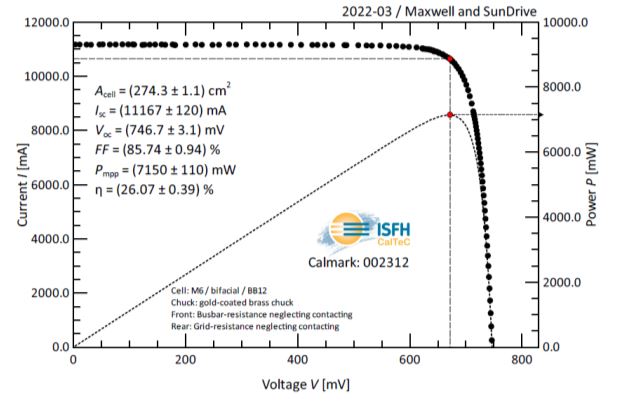Sydney-based SunDrive said it has teamed up with China-based heterojunction (HJT) equipment manufacturer Maxwell Technologies to demonstrate what it said is “the future potential for HJT solar cell efficiencies exceeding 26% in mass production.”
SunDrive said on Thursday that it has recorded a solar cell efficiency of 26.07% on a full-size silicon HJT solar cell. The company’s technology replaces the expensive silver used in conventional solar PV cells with cheaper and more abundant copper, by using large-scale production processes provided by Maxwell Technologies.
SunDrive, which set a new world record for commercial-sized silicon solar cell efficiency in September, said its latest results have been officially verified by Germany’s Institute for Solar Energy Research (ISFH). The results are more than 0.5% higher than the 25.54% world-record achievement announced by the company last year. SunDrive said the improvements have been observed in open-circuit voltage (Voc), short circuit current (Isc), and fill factor (FF). The improvement in efficiency due to “several equipment and processing upgrades,” the company said in an emailed statement.
The metallization of the HJT cell, with a total area of 274.3 cm2 (M6 size), was performed using SunDrive’s “latest generation of direct copper plating technology which achieves finer feature sizes and superior aspect ratios compared to commercial silver screen-printing technologies.”
Popular content
Silver is a key component in today’s solar panels with estimates indicating solar panel manufacturing accounts for about 20% of the world’s annual consumption of the precious metal. That volume is expected to increase as the next generation of high-efficiency cells currently being developed require up to three times more silver than their antecedents.
SunDrive’s solution, developed by Chief Executive Vince Allen during his PhD at the University of New South Wales (NSW) in Sydney, has been to replace the precious metal with copper. Allen said for solar to reach its full potential, solar cells need to be more efficient, and copper is the key to unlocking the floodgates of more efficient solar cell structures.
“Copper is around 100 times cheaper per kilogram and around 1,000 times more abundant than silver,” he said. “And aside from the abundancy and cost benefits of copper, we have found we can improve the efficiency above and beyond what is attainable with silver.”
The company, which successfully fabricated its first full-size panel in December, said it is planning to establish cell and module production operations in Australia by the end of 2023 to provide for the nation’s rooftop solar PV market and future utility-scale projects.
This content is protected by copyright and may not be reused. If you want to cooperate with us and would like to reuse some of our content, please contact: editors@pv-magazine.com.



1 comment
By submitting this form you agree to pv magazine using your data for the purposes of publishing your comment.
Your personal data will only be disclosed or otherwise transmitted to third parties for the purposes of spam filtering or if this is necessary for technical maintenance of the website. Any other transfer to third parties will not take place unless this is justified on the basis of applicable data protection regulations or if pv magazine is legally obliged to do so.
You may revoke this consent at any time with effect for the future, in which case your personal data will be deleted immediately. Otherwise, your data will be deleted if pv magazine has processed your request or the purpose of data storage is fulfilled.
Further information on data privacy can be found in our Data Protection Policy.